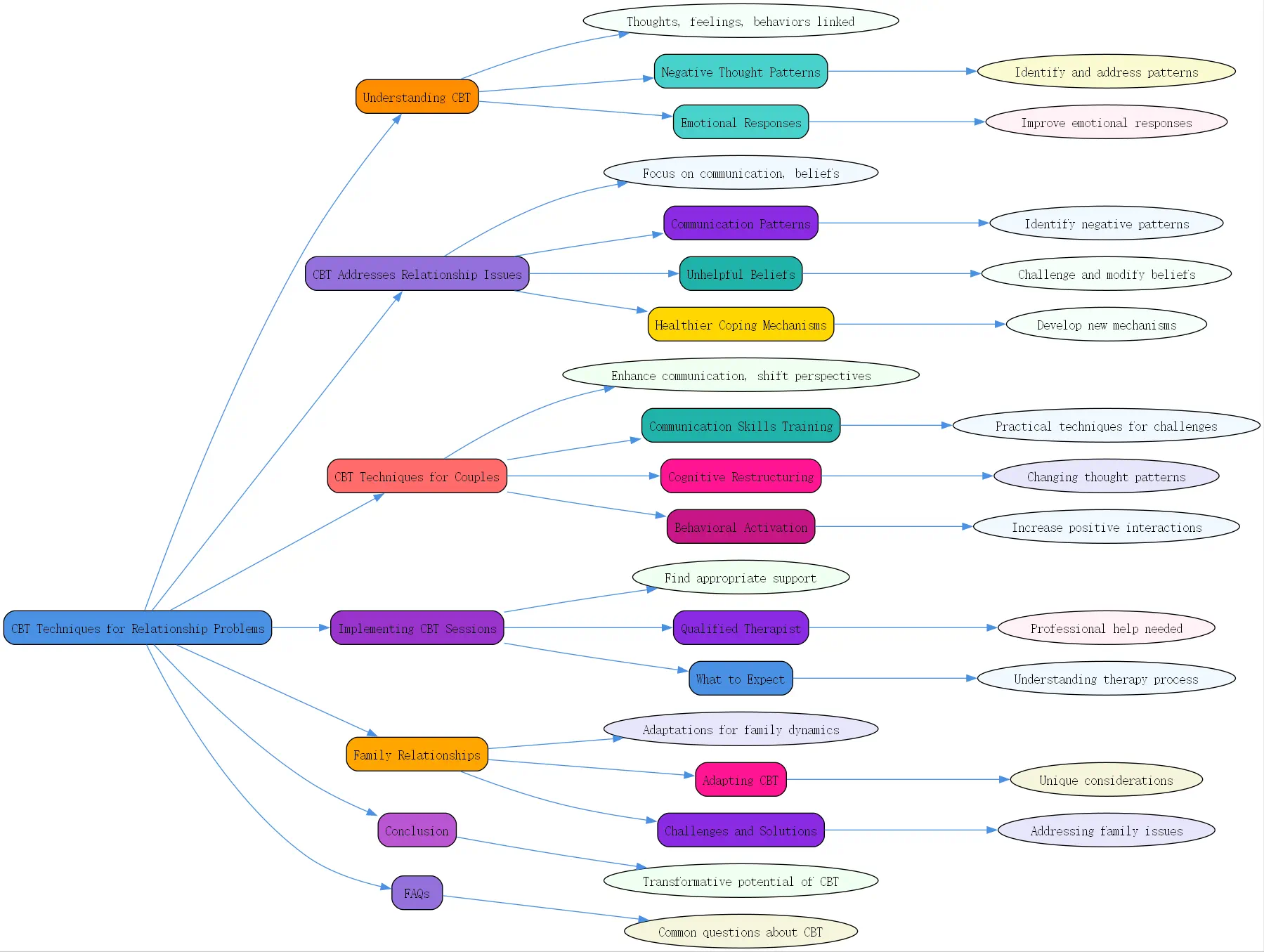Understanding Cognitive Behavioral Therapy (CBT)

Cognitive Behavioral Therapy (CBT) stands as one of the most extensively researched and effective psychological approaches for addressing a wide range of emotional and behavioral challenges. At its core, CBT operates on the principle that our thoughts, feelings, and behaviors are interconnected in powerful ways. When applied to relationships, this framework offers invaluable tools for couples struggling with communication breakdowns, recurring conflicts, and emotional disconnection.
The fundamental premise of CBT is that our thoughts and beliefs significantly influence how we feel and behave. In relationship contexts, negative thought patterns often develop over time, creating cycles of misunderstanding and conflict. For instance, if one partner consistently interprets the other’s silence as rejection rather than fatigue, this cognitive distortion can trigger feelings of hurt and defensive reactions, further straining the relationship.
CBT provides structured techniques to identify, challenge, and modify these unhelpful thought patterns. By examining the evidence for and against negative thoughts about our partners, we can develop more balanced perspectives that lead to healthier emotional responses and constructive interactions. This cognitive restructuring process helps partners move from automatic negative reactions to more thoughtful and compassionate exchanges.
How CBT Addresses Negative Thought Patterns
When relationship difficulties arise, our minds often default to unhelpful thinking styles. These might include “”mind reading”” (assuming we know what our partner is thinking), “”catastrophizing”” (imagining the worst possible outcomes), or “”all-or-nothing thinking”” (viewing situations in extreme terms). CBT teaches partners to recognize these patterns and replace them with more accurate and balanced thoughts.
Through regular practice, couples learn to pause and question automatic negative assumptions about each other’s intentions or behaviors. This cognitive shift creates space for curiosity and understanding rather than judgment and criticism. As partners become more aware of their thinking patterns, they can choose responses aligned with their relationship goals rather than reacting from distorted perceptions.

The Role of CBT in Improving Emotional Responses
Emotions in relationships can be intense and overwhelming, particularly during conflicts. CBT offers strategies to regulate these emotional responses by addressing the thoughts that fuel them. By learning to identify emotional triggers and the thoughts that accompany them, couples can develop greater emotional resilience and stability.
CBT techniques help partners distinguish between primary emotions (such as hurt or fear) and secondary emotions (like anger or defensiveness that may mask vulnerability). This awareness allows for more authentic emotional expression and creates opportunities for deeper connection. Through consistent practice, partners can transform their emotional reactions from sources of conflict to pathways for understanding and intimacy.
How CBT Addresses Relationship Issues
Relationship difficulties rarely exist in isolation—they typically develop as patterns of interaction that become entrenched over time. CBT offers a systematic approach to identifying and addressing these patterns, focusing particularly on communication dynamics, belief systems, and behavioral cycles.
Identifying Negative Communication Patterns
One of the first steps in relationship-focused CBT involves recognizing unhelpful communication patterns. These might include criticism, defensiveness, contempt, or stonewalling—behaviors that relationship researcher John Gottman identified as particularly damaging. Through CBT, couples learn to detect these patterns as they emerge and implement alternative approaches.
CBT helps partners become more aware of their communication styles and how these impact the relationship. By examining specific interactions and the thoughts and feelings that arise during difficult conversations, couples can identify their contribution to communication breakdowns. This awareness serves as the foundation for developing more effective ways of expressing needs and concerns.
Challenging and Modifying Unhelpful Beliefs
Our beliefs about relationships—often formed through childhood experiences, past relationships, or cultural messages—significantly influence how we interpret our partner’s behaviors. CBT for relationship problems helps identify these core beliefs and evaluate their accuracy and helpfulness.
For example, a belief that “”expressing vulnerability is dangerous”” might prevent a partner from sharing important needs. Through CBT sessions for couple relationships, partners can explore the origins of these beliefs, test their validity, and develop more adaptive perspectives. This process often involves examining evidence that contradicts negative beliefs and practicing new ways of thinking about the relationship.
Developing Healthier Coping Mechanisms
When faced with relationship stress, many people resort to unhelpful coping strategies such as withdrawal, aggression, substance use, or excessive reassurance-seeking. CBT provides alternatives by teaching skills for tolerating distress, regulating emotions, and communicating effectively even during challenging moments.
These healthier coping mechanisms might include taking a brief timeout when emotions run high, practicing relaxation techniques, engaging in perspective-taking, or using structured communication approaches. By expanding their repertoire of coping strategies, couples become better equipped to navigate relationship challenges without resorting to behaviors that damage connection.
Effective CBT Techniques for Couple Relationship
CBT offers a rich toolkit of practical techniques specifically designed to address common relationship challenges. These approaches can transform relationship dynamics by enhancing communication, shifting perspectives, and increasing positive interactions.
Communication Skills Training
Effective communication forms the foundation of successful relationships, yet many couples struggle to express themselves clearly or listen attentively, especially during conflicts. CBT provides structured approaches to develop these essential skills.
Active Listening and Empathetic Responses
Active listening involves fully focusing on understanding your partner rather than formulating your response. Through managing anxiety in a relationship with CBT techniques, partners learn to demonstrate their attention through nonverbal cues, paraphrasing to confirm understanding, and asking clarifying questions before responding.
Empathetic responses go beyond simply hearing words—they involve attempting to understand the emotions and perspectives behind those words. CBT teaches partners to validate each other’s experiences even when they disagree, creating emotional safety that facilitates deeper connection. This validation doesn’t require agreement but acknowledges the legitimacy of each person’s feelings.

Expressing Needs and Feelings Assertively
Many relationship conflicts stem from unexpressed or poorly communicated needs. CBT helps partners express themselves using “”I”” statements that communicate feelings and needs without blame or criticism. This approach reduces defensiveness and increases the likelihood that partners will hear and respond constructively to each other’s concerns.
Assertive communication balances honesty with respect, allowing partners to address important issues without damaging the relationship. Through regular practice, couples develop confidence in expressing their authentic needs while remaining open to their partner’s perspective.
Techniques for Conflict Resolution
Conflict is inevitable in relationships, but how couples manage disagreements significantly impacts relationship satisfaction. CBT provides structured approaches to conflict resolution, including timeout protocols, problem-solving frameworks, and compromise strategies.
These techniques help couples move from win-lose dynamics to collaborative problem-solving, where both partners’ concerns receive attention and respect. By learning to focus on specific issues rather than attacking character, couples can address conflicts more productively and maintain emotional connection even during disagreements.
Cognitive Restructuring in Relationships
Our thoughts about our partner and the relationship profoundly influence our satisfaction and behavior. Cognitive restructuring techniques help identify and modify unhelpful thought patterns that contribute to relationship distress.
Identifying and Challenging Negative Thoughts about Partner
Negative interpretations of a partner’s behavior often become automatic over time, creating a filter through which all interactions are viewed. CBT techniques for relationship problems include identifying these negative automatic thoughts and examining their accuracy through evidence-gathering and perspective-taking exercises.
Partners learn to distinguish between observations (what actually happened) and interpretations (the meaning assigned to these events). By questioning assumptions and considering alternative explanations for behavior, couples can break free from negative thinking cycles that damage trust and connection.
Reframing Perceptions to Improve Understanding
Reframing involves looking at situations from different perspectives to develop more balanced and compassionate interpretations. In relationship contexts, this might include considering positive intentions behind seemingly negative behaviors or recognizing how stress or past experiences might influence a partner’s reactions.
Through regular practice, partners develop the habit of generating multiple interpretations for challenging situations rather than defaulting to the most negative explanation. This cognitive flexibility creates space for understanding and compassion rather than judgment and criticism.
Promoting Realistic Expectations in the Relationship
Unrealistic expectations often set relationships up for disappointment. CBT helps couples identify and modify expectations that create unnecessary pressure or dissatisfaction. This process involves distinguishing between needs (essentials for relationship satisfaction) and wants (preferences that aren’t fundamental to relationship health).
By developing realistic expectations informed by an understanding of human limitations and differences, couples can reduce unnecessary disappointment and create relationships based on acceptance rather than idealization. This doesn’t mean settling for an unfulfilling relationship but rather appreciating the complexity of human connection.
Behavioral Activation for Couples
While thoughts and communication patterns significantly impact relationships, behaviors also play a crucial role in maintaining connection. Behavioral activation techniques focus on increasing positive interactions and creating opportunities for shared enjoyment.
Planning Enjoyable Activities Together
Many couples find that quality time diminishes as relationships progress, particularly when facing challenges or life transitions. CBT for relationship problems includes systematically scheduling enjoyable activities that strengthen connection and create positive shared experiences.
These activities might range from simple daily rituals to special occasions, with the emphasis on engagement and presence rather than elaborate planning. By protecting time for connection and enjoyment, couples maintain the friendship foundation that supports them through challenges.
Increasing Positive Interactions
Research suggests that thriving relationships maintain a ratio of at least five positive interactions for every negative one. Behavioral activation techniques help couples intentionally increase positive exchanges through appreciation practices, affection, humor, and support.
These positive interactions serve as emotional deposits in the relationship bank account, building resilience for times of stress or conflict. Small gestures of kindness and appreciation often contribute more to relationship satisfaction than grand romantic gestures.
Reducing Avoidance Behaviors
When relationships become distressed, partners often develop avoidance patterns to minimize conflict or discomfort. While these behaviors provide temporary relief, they prevent addressing important issues and create emotional distance. CBT helps identify avoidance patterns and develop strategies for engaging with challenging relationship aspects constructively.
By gradually confronting avoided conversations or situations with new skills and perspectives, couples can break cycles of avoidance that prevent relationship growth and resolution. This approach acknowledges discomfort while providing tools to navigate it effectively.
Implementing CBT Sessions for Couple Relationship
For couples interested in applying CBT principles to their relationship, finding appropriate support and understanding the therapeutic process can enhance outcomes and satisfaction.
Finding a Qualified CBT Therapist
The effectiveness of CBT for relationship problems depends significantly on working with a properly trained professional. When seeking a therapist, couples should consider credentials, specialization in couples work, and experience with CBT approaches specifically.
Many mental health professionals offer family relationship building techniques informed by CBT principles, but specialized training in couples therapy ensures familiarity with relationship dynamics and interventions. Professional organizations like the American Association for Marriage and Family Therapy or the International Centre for Excellence in Emotionally Focused Therapy provide directories of qualified professionals.

Online therapy options have expanded access to CBT for many couples, offering convenience and flexibility. Research suggests that properly delivered online therapy can be as effective as in-person treatment for many issues. When considering online options, couples should ensure platforms offer adequate privacy protection and therapists maintain appropriate licensure.
What to Expect in CBT for Relationship Problems
Effective CBT for couples typically begins with a thorough assessment of relationship patterns, individual concerns, and goals for therapy. This process helps the therapist understand each partner’s perspective and develop an appropriate treatment plan tailored to the couple’s specific needs.
Unlike some approaches that focus exclusively on communication or emotional expression, CBT provides structured homework assignments and practice exercises to reinforce skills between sessions. These might include thought records, communication practice, or relationship-building activities designed to implement new patterns in daily life.
Regular monitoring of progress helps tailor the therapeutic approach to each couple’s needs and circumstances. This might involve formal assessments or simply checking in about changes in satisfaction, communication patterns, or conflict frequency. Based on this feedback, interventions can be adjusted to address emerging concerns or build on successful changes.
Family Relationship Building Techniques & Considerations
While many CBT techniques apply across different relationship contexts, family dynamics present unique considerations that may require additional approaches and adaptations.
Adapting CBT for Family Dynamics
Family relationships involve complex interconnections between multiple individuals across generations, creating patterns that extend beyond simple dyadic interactions. CBT for families acknowledges these complex dynamics while providing practical tools for addressing specific challenges.
Intergenerational patterns often influence current family functioning, with communication styles, belief systems, and behavioral tendencies passed down across generations. Through CBT, family members can identify these patterns and make conscious choices about which traditions and approaches to maintain or modify.
Involving all relevant family members in the therapeutic process ensures that changes reflect the needs and perspectives of the entire system. However, this comprehensive approach requires skillful facilitation to ensure that all voices receive appropriate attention and that power dynamics don’t undermine therapeutic progress.
Age-appropriate modifications help ensure that CBT techniques remain accessible and relevant for all family members. For younger children, this might involve play-based approaches or simplified explanations, while adolescents might benefit from technology integration or peer-oriented framing. These adaptations maintain core CBT principles while acknowledging developmental differences.
Potential Challenges and Solutions in Family CBT
Resistance to therapy commonly emerges in family contexts, particularly when members hold different perspectives about the nature or existence of problems. BrainTalking professionals recommend addressing resistance directly through motivational interviewing techniques, emphasizing shared goals, and honoring each person’s perspective while establishing a collaborative framework.
Family therapy inevitably involves navigating different and sometimes conflicting perspectives about relationship issues and potential solutions. CBT provides structured approaches for acknowledging these differences while identifying common ground and shared values that can guide collaborative problem-solving efforts.
Maintaining consistent implementation of new skills and approaches presents challenges in busy family life. CBT addresses this through graduated practice, environmental modifications, and accountability systems that support sustainable change. By acknowledging the challenges of implementation while providing practical strategies for overcoming barriers, families can develop lasting relationship improvements.
Conclusion: The Transformative Potential of CBT for Relationships
The application of CBT techniques for relationship problems offers couples and families powerful tools for addressing communication breakdowns, negative thinking patterns, and behavioral cycles that undermine connection. Through systematic identification and modification of unhelpful cognitions and behaviors, relationships can transform from sources of stress to foundations of support and fulfillment.
While the journey toward relationship improvement requires commitment and consistent effort, the structured nature of CBT provides clear direction and measurable progress markers. By combining cognitive restructuring, communication skills development, and behavioral activation, couples and families can create relationships characterized by understanding, respect, and genuine connection.
For those experiencing relationship challenges, CBT offers hope through evidence-based approaches that address both immediate concerns and underlying patterns. Whether implemented through professional therapy or self-guided practice, these techniques provide a pathway toward more satisfying and resilient relationships.
FAQs About CBT for Relationship Issues
How long does CBT for relationship problems typically take?
The duration of CBT for relationships varies depending on the specific challenges, commitment to practice, and therapeutic approach. Many couples see meaningful improvements within 12-16 weekly sessions, though complex issues may require longer treatment. The structured nature of CBT often allows for more efficient progress compared to open-ended therapeutic approaches.
Can CBT help if only one partner is willing to participate?
While involving both partners creates optimal conditions for relationship improvement, individuals can still benefit from learning CBT techniques independently. By changing one’s contributions to relationship patterns, the dynamic may shift positively. However, some relationship issues require mutual participation for effective resolution.




